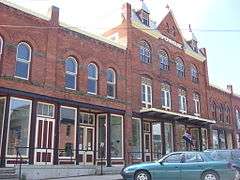Earlville Opera House
|
Earlville Opera House | |
|
Earlville Opera House, May 2009 | |
  | |
| Location | 12-20 E. Main St., Earlville, New York |
|---|---|
| Coordinates | 42°44′22″N 75°32′41″W / 42.73944°N 75.54472°WCoordinates: 42°44′22″N 75°32′41″W / 42.73944°N 75.54472°W |
| Area | less than one acre |
| Built | 1890 |
| NRHP Reference # | 73001169[1] |
| Added to NRHP | January 22, 1973 |
Earlville Opera House is a historic theater at Earlville in Chenango County, New York. It was built in 1890 and occupies four of the eight units of the Douglass Block. The three story opera house rises above the two story annex with the theater and balcony occupying the second and third floors, while storefronts are housed on the first floor. The heyday of the opera house was from the 1890s to the 1920s; in 1937 it was renovated for talking motion pictures and was in use as a movie house until 1950. It is located within the Earlville Historic District.[2] It is used as a community arts center.
It was added to the National Register of Historic Places in 1973.[1]
The Earlville Opera House is a wonderful, largely intact, acoustically perfect historic theater. Managed by a stable, well-established, debt-free, community-based organization, the building is the home of an exceptional summer performance series (now in its 42nd year), two visual arts galleries, an Artisan Gift Shop featuring the work of regional artists and a workshop series in response to community needs and a variety of cultural activities. Currently, the EOH Board of Directors is fundraising for a comprehensive rehabilitation of the building and theater that will accomplish three objectives: 1. the project will address much-needed structural repairs, including improving accessibility to the public; 2. the project will allow the facility to be used on a year-round, as opposed to a seasonal, basis, thereby assisting in preserving the building and expanding the market which the organization serves; and 3. the project will enable the organization to expand its cultural and arts activities, by providing space for drama and art workshops, additional performances, improved gallery space, a film series, and arts-in-education activities. The historic facility, which currently draws its constituency from more than a forty-mile radius (including the markets of Syracuse, Utica and Binghamton), serves far more than its own village, and will address the current and future needs of a large regional community by expanding the availability of the arts and culture in rural New York, undertaking critical historical preservation, and enhancing the economic vitality of the Madison-Chenango Counties area.
The Earlville Opera House is a community-based organization with a two-fold mission: to preserve and restore the EOH theater, a unique, second-story theater originally constructed in 1892 and currently on the National Historic Register; and to promote the arts in a rural region of Central New York by offering programs of cultural, educational, and historic significance. The EOH offers a summer performance series, which annually brings over 5,000 people from a wide region to the Village of Earlville. Renowned for its quality and diversity, the series includes children’s performances, jazz, folk, classical, bluegrass, blues, Celtic, Cajun, Zydeco, and other genres, including drama and more, and incorporates well-known national artists, as well as lesser-known regional artists - including children’s theater workshops and productions. The EOH also offers year-round art galleries and art workshops. In addition, the EOH promotes the economic vitality of the region. The proposed uses of the facility offer opportunities to expand significantly the arts and cultural activities provided.
History of more than one Opera House on the current site: Fire visited the first Opera House soon after it was built in 1890. The village with the help of Newell Douglass constructed a second opera house in the Douglass block on East Main Street but it too burned on March 31, 1892, when half of the Douglass block was consumed in the blaze. The village rallied again and the current Opera House was completed by November 1892 on the same site.
References
- 1 2 National Park Service (2009-03-13). "National Register Information System". National Register of Historic Places. National Park Service.
- ↑ Steven Levy (November 1972). "National Register of Historic Places Registration: Earlville Opera House". New York State Office of Parks, Recreation and Historic Preservation. Retrieved 2010-02-20. See also: "Accompanying three photos".


